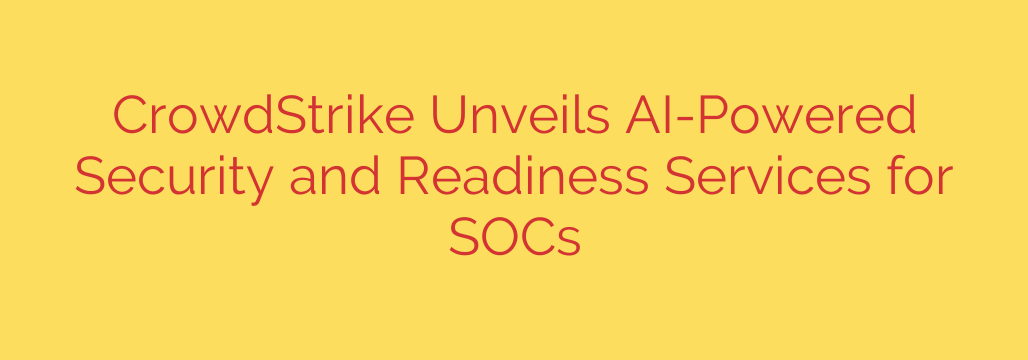
Beyond the Alert: How AI and Proactive Threat Hunting are Reshaping SOC Security
Security Operations Centers (SOCs) are the front line in the global war against cybercrime. Yet, for years, they have been struggling against a rising tide of challenges. Overwhelmed by an avalanche of alerts, hampered by a persistent cybersecurity skills gap, and facing increasingly sophisticated adversaries, many SOC teams are stretched to their breaking point. The traditional, reactive model of cybersecurity is no longer enough.
A fundamental shift is underway, moving the industry from merely responding to threats to proactively hunting them down and preparing for attacks before they ever launch. This new era is powered by a potent combination of artificial intelligence and elite human expertise, designed to empower SOCs and give defenders the upper hand.
The Modern SOC’s Dilemma: Drowning in Data
The core problem for many security teams isn’t a lack of data, but a lack of actionable insight. A typical SOC is flooded with alerts from dozens of different security tools. Analysts spend countless hours sifting through this noise, trying to distinguish real threats from false positives. This constant pressure leads to:
- Alert Fatigue: Analysts become desensitized to warnings, increasing the risk that a critical alert will be missed.
- Team Burnout: The high-stress, high-stakes environment contributes to employee turnover, worsening the skills shortage.
- Missed Threats: Sophisticated attackers often use subtle techniques that don’t trigger obvious alarms, allowing them to lurk undetected in a network for weeks or months.
Simply put, waiting for an alarm to go off is a failing strategy. The future of defense lies in actively seeking out adversaries before they can achieve their objectives.
The Rise of Proactive Threat Hunting and Managed Response
To combat these challenges, a new model of security is gaining prominence, centered on continuous, proactive defense. This approach goes beyond automated alerts to actively search for the faint signals of an ongoing or impending attack.
The most effective strategy combines the scale of AI with the intuition of human experts. AI-native platforms can analyze trillions of data points in real time to identify suspicious patterns that would be invisible to a human. This data is then escalated to elite threat hunters who investigate, analyze the context, and determine if an adversary is at work.
This is the essence of proactive threat hunting: a dedicated, 24/7 operation to find and neutralize stealthy threats that have bypassed standard security controls. By finding these “unknown unknowns,” organizations can stop breaches before they lead to catastrophic data loss or operational disruption.
Expanding Access to Elite Security Expertise
Historically, this level of proactive threat hunting and managed detection and response (MDR) was only accessible to the largest enterprises with massive security budgets. However, that is rapidly changing.
Leading security platforms are now empowering a broader network of Managed Security Service Providers (MSSPs) to deliver these elite services. By equipping MSSPs with advanced, AI-native tools and expert support, world-class security becomes accessible to small and medium-sized businesses that lack in-house resources. This approach helps bridge the cybersecurity skills gap and democratizes high-level security, ensuring organizations of all sizes can defend themselves against top-tier threats.
From Defense to Resilience: The Importance of Cyber Readiness
Stopping active threats is critical, but true security maturity comes from building resilience. The most forward-thinking organizations understand that it’s not a matter of if an attack will occur, but when. Preparing for that eventuality is the key to minimizing its impact.
This has led to the development of comprehensive readiness services designed to harden defenses and prepare teams for a crisis. The goal is to move from a reactive incident response model to a proactive state of cyber readiness. This is achieved through several key activities:
- Incident Response Plan Development: Creating a clear, actionable plan that outlines roles, responsibilities, and procedures for responding to a security breach.
- Readiness Assessments: A thorough review of an organization’s security posture, identifying gaps in technology, processes, and personnel before an attacker can exploit them.
- Tabletop Exercises: Guided, discussion-based sessions where leadership and technical teams walk through a simulated cyberattack scenario. This tests the incident response plan in a low-stakes environment and builds crucial muscle memory.
- Adversary Emulation: Controlled, real-world attack simulations (often called Red or Purple Teaming) where ethical hackers mimic the tactics of known threat groups to test a network’s defenses and the SOC’s ability to detect and respond.
By engaging in these readiness activities, an organization can confidently answer the question, “Are we ready?” long before a real crisis hits.
In conclusion, the landscape of cybersecurity is evolving. For SOCs to succeed against modern adversaries, they must move beyond the alert. By embracing a strategy that blends the power of AI, the skill of human experts, proactive threat hunting, and a relentless focus on readiness, organizations can transform their security posture from reactive defense to proactive dominance.
Source: https://datacenternews.asia/story/crowdstrike-launches-new-ai-security-readiness-services-for-socs








